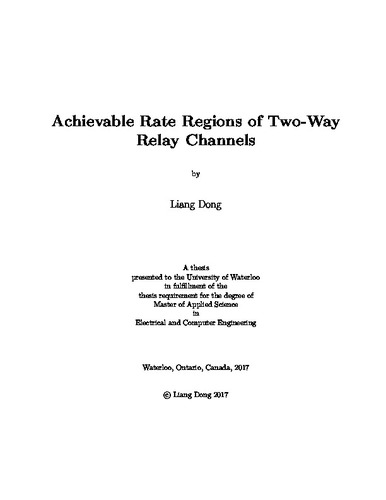| dc.contributor.author | Dong, Liang | |
| dc.date.accessioned | 2017-01-19 23:48:26 (GMT) | |
| dc.date.available | 2017-01-19 23:48:26 (GMT) | |
| dc.date.issued | 2017-01-19 | |
| dc.date.submitted | 2017 | |
| dc.identifier.uri | http://hdl.handle.net/10012/11216 | |
| dc.description.abstract | With the fast development of communication networks, cooperative communication has been more widely used in many different fields, such as satellite networks, broadcast networks, internet and so on. Therefore relay channels have been playing a pivotal role since their definitions were proposed by Van-der Meulen. However, the general achievable rate region of a relay channel is still unknown which inspires more people to persistently work on. There are several different kinds of coding schemes proposed by people after relay channels came into our lives. Until now, the two most commonly used coding strategies of relay channels are Decode-and-Forward and Compress-and-Forward. In this thesis we will provide a way to obtain the achievable rate region for two-way relay channels by using decode-and-forward coding.
With the knowledge of basic information theory and network information theory, we will focus our study on the achievable rates of relay channels. Most of the previous study of relay channels are aiming to find a more general achievable rate region. In this thesis, an intuitional way will be used to study four-terminal relay channels. This method makes a good use of the information from three-terminal relay channels by separating a four-terminal relay channel into two parts: (1). a three-terminal relay channel; (2). a common end node. The final achievable rate region is obtained by combing together the separate achievable rates of the two parts. We split the complex model to two easier ones, this idea may give help for doing researches on more complicated channels.
Eliminating interferences is also a difficulty in the study of relay channels. Comparing with the achievable rate regions of two-way two-relay channels which have already been proved, we found that it is feasible to separate a two-way two-relay channel into a three-terminal relay channel and an common end node. Therefore, we apply this method to all two-way four-terminal relay channels. After fixing two different source nodes, all of the possible transmission schemes are presented in this thesis. However not all of the four-terminal channels can be separated into two parts. By studying the schemes failed to be decomposed to a three-terminal relay channel and a common end node, we found that these schemes are infeasible for message transmission. Thus our method can still be used to study on feasible two-way relay channels. | en |
| dc.language.iso | en | en |
| dc.publisher | University of Waterloo | en |
| dc.title | Achievable Rate Regions of Two-Way Relay Channels | en |
| dc.type | Master Thesis | en |
| dc.pending | false | |
| uws-etd.degree.department | Electrical and Computer Engineering | en |
| uws-etd.degree.discipline | Electrical and Computer Engineering | en |
| uws-etd.degree.grantor | University of Waterloo | en |
| uws-etd.degree | Master of Applied Science | en |
| uws.contributor.advisor | Xie, Liang-Liang | |
| uws.contributor.affiliation1 | Faculty of Engineering | en |
| uws.published.city | Waterloo | en |
| uws.published.country | Canada | en |
| uws.published.province | Ontario | en |
| uws.typeOfResource | Text | en |
| uws.peerReviewStatus | Unreviewed | en |
| uws.scholarLevel | Graduate | en |

